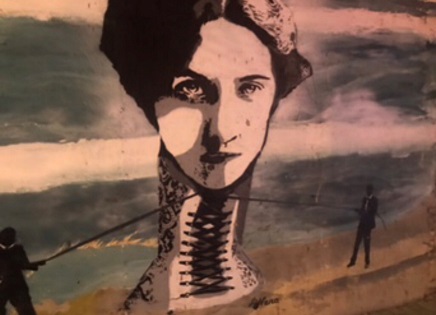Student Experience: Study Trip to Valencia by Rebecca Bulayima (BA English – Year 2)
In March of this year, we embarked on a study trip to Valencia. As well as attending lectures on English language and literature, we toured the most intricate and elaborate parts of the city and bathed in the tranquility of the city’s coast and traditional outskirts. The module was a platform to encourage and celebrate our creativity as we were tasked to create a portfolio which consisted of an artefact. This artefact had to demonstrate the use, and influences, of the English language and literature in Valencia. La Nena Wapa Wapa, a Spanish street artist, uses her art to expose the pervading issue of gender inequality in Spain. The street art is an effective way of raising awareness since the images are mutually intelligible despite any language barriers. For my artefact, I decided to compose a piece of music that reflects the messages conveyed through Valencia’s street art.

The composition is called ‘La Lucha’ meaning, ‘the fight’ and can be viewed using this link:
La Lucha begins with a descending ‘ostinato’, a repetitive musical idea, to create a sense of relentless oppression due to its lack of pause for relief. I’ve also used counter rhythms to audibly demonstrate ‘the fight’ between the sexes. The composition consists of different two instruments:
- The guitars represent masculinity through their use of ‘staccato’ (detached) and accented notes, showing aggression. Likewise, their stability and control is demonstrated through the ostinato being ‘conjunct’ (stepwise; a musically stable interval).
- The violins play ‘legato’ (smoothly) and ‘lacrimoso’ (in a tearful way). This adds a sombre, melancholic feel to the music, demonstrating women’s suffering in inequality.
In addition to this, an audible representation of the Spanish women’s weaker voice is depicted by the violins attempting to overpower the guitar voices but ultimately failing since the piece starts and ends with a guitar. The piece starting and ending in the same way is to create a sense of cyclicality to replicate the fact that the Spanish women are currently trapped in this traditional patriarchal culture. The use of disjunct intervals (leaps between notes) make the violin’s melodic line angular to show discomfort and to create a sense of yearning for freedom from the previously established musical patterns. This is inspired by the women’s yearning for freedom from the traditional patriarchal norms. The lack of cadential resolution at the end demonstrates that the battle for gender equality is still being fought.
The street art depicting social injustice serves as a voice for the voiceless. I have tried to capture this meaning in my artefact. Enjoy!